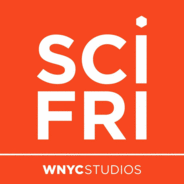If you’ve found yourself scrolling through the breastfeeding world online, you know that people have a lot of strong opinions about breast milk. But what exactly do we know about the biology of it? Does breast milk really adapt to a baby’s needs? Does it confer immunity? How does making breast milk impact the breastfeeder? Joining Host Flora Lichtman to spin through the science of this sophisticated substance are experts Shelley McGuire and Deepshika Ramanan.Guests: Dr. Shelley McGuire is the director of the Margaret Ritchie School of Family and Consumer Sciences at the University of Idaho.Dr. Deepshika Ramanan is an assistant professor at the Salk Institute for Biological Studies.Transcripts for each episode are available within 1-3 days at sciencefriday.com.
Subscribe to this podcast. Plus, to stay updated on all things science, sign up for Science Friday's newsletters.

Talk
Science Friday Folgen
Covering the outer reaches of space to the tiniest microbes in our bodies, Science Friday is the source for entertaining and educational stories about science, technology, and other cool stuff.
Folgen von Science Friday
1182 Folgen
-
Folge vom 14.08.2025Breast Milk Is Understudied. What Are Scientists Learning Now?
-
Folge vom 13.08.2025When Headaches Are Ruining Your Life, Where Can You Turn?Science journalist Tom Zeller Jr. has suffered from debilitating cluster headaches for three decades. Like other cluster headache sufferers, his episodes would leave him unable to function, and the fear of the next one happening was constant. In a quest to better understand his own condition, Zeller learned that headaches remain a great neurological mystery, with basic mechanisms behind why they happen still unknown. He joins Host Flora Lichtman to talk about his new book, The Headache: The Science of a Most Confounding Affliction – and a Search for Relief.Guest:Tom Zeller Jr. is editor in chief of Undark and author of the book The Headache: The Science of a Most Confounding Affliction – and a Search for Relief. He’s based in Montana.Transcripts for each episode are available within 1-3 days at sciencefriday.com. Subscribe to this podcast. Plus, to stay updated on all things science, sign up for Science Friday's newsletters.
-
Folge vom 12.08.2025Remembering Apollo 13 Astronaut James LovellLast week, astronaut James Lovell died at the age of 97. In April of 1970, he was the commander of the Apollo 13 mission, which launched with three astronauts en route to the moon. While in space, however, the craft encountered a serious problem: an explosion in one of its fuel tanks that severely damaged the craft and disabled its electrical system, prompting the famous phrase, “Houston, we’ve had a problem.” In 1995, on the occasion of the 25th anniversary of the mission, Host Ira Flatow spoke with Lovell about the historic flight and how good luck and ingenuity among the crew and mission controllers on the ground combined to bring the Apollo 13 astronauts safely back to Earth.Guest:James Lovell was a NASA astronaut and commander of the Apollo 13 mission.Transcripts for each episode are available within 1-3 days at sciencefriday.com. Subscribe to this podcast. Plus, to stay updated on all things science, sign up for Science Friday's newsletters.
-
Folge vom 11.08.2025‘Underground Atlas’ Shows How Vulnerable Fungal Networks AreFungal networks in the soil are arguably the basis of much of life on Earth, but they’re understudied and underappreciated in the conservation world. Scientists at the Society for the Protection of Underground Networks (SPUN) are trying to fix that. They just unveiled a global map of mycorrhizal fungal networks, which highlights how widespread they are and how little protection they have. Host Flora Lichtman talks with two of the SPUN mapmakers, Adriana Corrales and Michael Van Nuland, about the importance of fungal networks and why they need more protection.Guests: Dr. Adriana Corrales is a forest ecologist and scientist with the Society for the Protection of Underground Networks. She’s based in Bogotá, Colombia.Dr. Michael Van Nuland is an ecologist and scientist with the Society for the Protection of Underground Networks. He’s based in Portland, Oregon.Transcripts for each episode are available within 1-3 days at sciencefriday.com. Subscribe to this podcast. Plus, to stay updated on all things science, sign up for Science Friday's newsletters.
